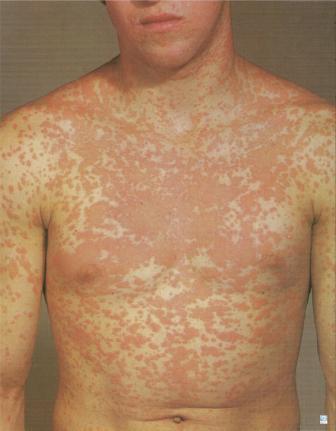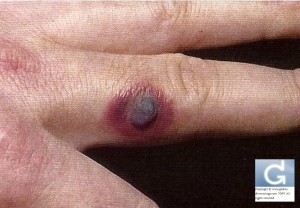Tabagisme et peau
Drug reactions (drug allergy)
Dr Christophe Hsu – dermatologist. Geneva, Switzerland
- A Drug allergy is an unwanted side effect of drugs or medication that are ingested (or injected) into our body. Drug reactions are divided into intolerance and allergies. Drug allergy reactions can affect the skin as well as internal organs of the body.
- It is important for a person to recognize the drugs that he is allergic to, because drug allergy reactions can be life-threatening. Once a person has developed an allergy to a drug, he remains allergic to the drug for the rest of his life. The drug has to be avoided permanently. Drugs can also cause adverse reactions in other ways (pigmentation, hair loss, vomiting, diarrhoea…)
What are the skin symptoms and signs of drug allergy ?
- The skin is often the most obvious organ of our body to be affected in drug allergy. While most skin reactions in drug allergy are mild, some reactions can be life- threatening.
A. Serious skin reactions in drug allergy include:
- Urticaria/Angioedema/Anaphylaxis
- Urticaria (hives) resembles insect bite reaction in appearance.
- It appears as itchy red, thick swollen patches on the limbs and body and as puffy swelling on the eyelids and lips. It appears very quickly; usually within less than 60 minutes after ingestion of the drug. Swelling occuring in the wind pipe can result in obstruction and asphyxiation and death.
- Erythema Multiforme (Stevens Johnson Syndrome)
- This is a severe skin reaction presenting as red rounded patches resembling a bull’s eye on the limbs and body. The patches tend to expand and join together. Blisters may develop and the skin may peel away. The lining of the eyes, mouth and genitals may peel off. If not recognized and treated early, death can occur.
B. Less severe skin drug reactions
- Measles-like rash (morbilliform) – maculo-papular eruptions

- Morbilliform drug eruption
- This is the commonest presentation of drug allergy. The rashes consist of small raised pin-head reddish eruptions and flat red patches on the limbs and trunk resembling measles. The rash is often itchy. The rash usually appears several days after ingestion of the drug.
- Fixed Drug Eruptions (FDE)
- This is a type of very localized drug allergy. Several days after ingestion of the drug, one or two small to large, round or oval patches appear on any part of the skin. The lesion becomes dark after several months and fade away. The skin lesion recurs on the same spot whenever the person ingests the drug.

- Fixed Drug Eruption (FDE) (more pictures)
What are the drugs that often cause allergy ?
- Any drug can cause drug allergy. The following are the common drugs:
- Analgesics (pain killers) and anti-rheumatics eg. aspirin, paracetamol, indomethacin, Saridon.
- Antibiotics eg. penicillins, tetracycline, sulphonamides (Bactrim/Septrin).
- Anti-epileptics eg. phenytoin, carbamazepine.
How do you prevent drug allergy ?
- Avoid self-medication.
- Take medication only on your doctor’s advice.
- Consult your doctor immediately when you suspect you have developed a drug allergy so that your allergy can be confirmed and documented permanently.
- Record the name of the drug you are allergic to.
- Always inform your doctor of your drug allergy during each consultation.
What to do when you suppect you have developed drug allergy ?
- Stop all medications but do not throw them away.
- Consult your doctor immediately. Go back to the doctor who prescribed the medications. Get his advice.
- Show all your medications (including those taken recently and long term medication)
Contributors:
Dr Christophe HSU – dermatologist. Geneva, Switzerland
National Skin Centre. Singapore
Español Italiano Deutsch 日本語 Tagalog Português
Related posts
